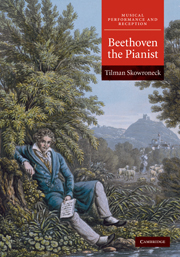Book contents
- Frontmatter
- Contents
- Acknowledgments
- Abbreviations and conventions
- Introduction
- PART I BEETHOVEN, HIS PLAYING, AND HIS INSTRUMENTS
- PART II SOUND IDEAL AND PERFORMANCE
- PART III SOUND IDEAL, NOTATION, AND STYLISTIC CHANGE
- Introduction
- 7 Common touch and legato
- 8 The performance of Beethoven's trills
- Epilog
- Bibliography
- Index
7 - Common touch and legato
from PART III - SOUND IDEAL, NOTATION, AND STYLISTIC CHANGE
Published online by Cambridge University Press: 06 July 2010
- Frontmatter
- Contents
- Acknowledgments
- Abbreviations and conventions
- Introduction
- PART I BEETHOVEN, HIS PLAYING, AND HIS INSTRUMENTS
- PART II SOUND IDEAL AND PERFORMANCE
- PART III SOUND IDEAL, NOTATION, AND STYLISTIC CHANGE
- Introduction
- 7 Common touch and legato
- 8 The performance of Beethoven's trills
- Epilog
- Bibliography
- Index
Summary
CONFLICTING OPINIONS ABOUT THE DETACHED STYLE
In Beethoven's legato style, the quest for a singing fortepiano tone and the manifestation of a singing manner of playing are combined. One source that depicts Beethoven's legato practice is Carl Czerny's recollection of his first fortepiano lessons with Beethoven in the winter of 1799–1800. Czerny was introduced to Beethoven and played a few pieces for him; Beethoven agreed to teach him. Czerny relates:
After I had finished, Beethoven turned to my father and said: “The boy has talent, I want to teach him myself and I will take him as a pupil. Send him to me a few times every week. Above all, get him Emanuel Bach's tutor on the true manner of playing the Clavier, which he must bring along the very next time.”
During the first lessons, Beethoven kept me exclusively busy with scales in all the keys, showed me the only right position of the hands, the fingers, and especially the use of the thumb (at that time still unknown to most players) – only much later did I learn to understand the full extent of the usefulness of these rules.
Then he went with me through the exercise pieces that belong to this tutor and especially drew my attention to the legato, which he himself mastered in an unsurpassed fashion and which all other pianists at that time judged to be unattainable on the fortepiano, since (still from Mozart's time) the chopped and shortly articulated way of playing was in fashion.
- Type
- Chapter
- Information
- Beethoven the Pianist , pp. 172 - 216Publisher: Cambridge University PressPrint publication year: 2010



